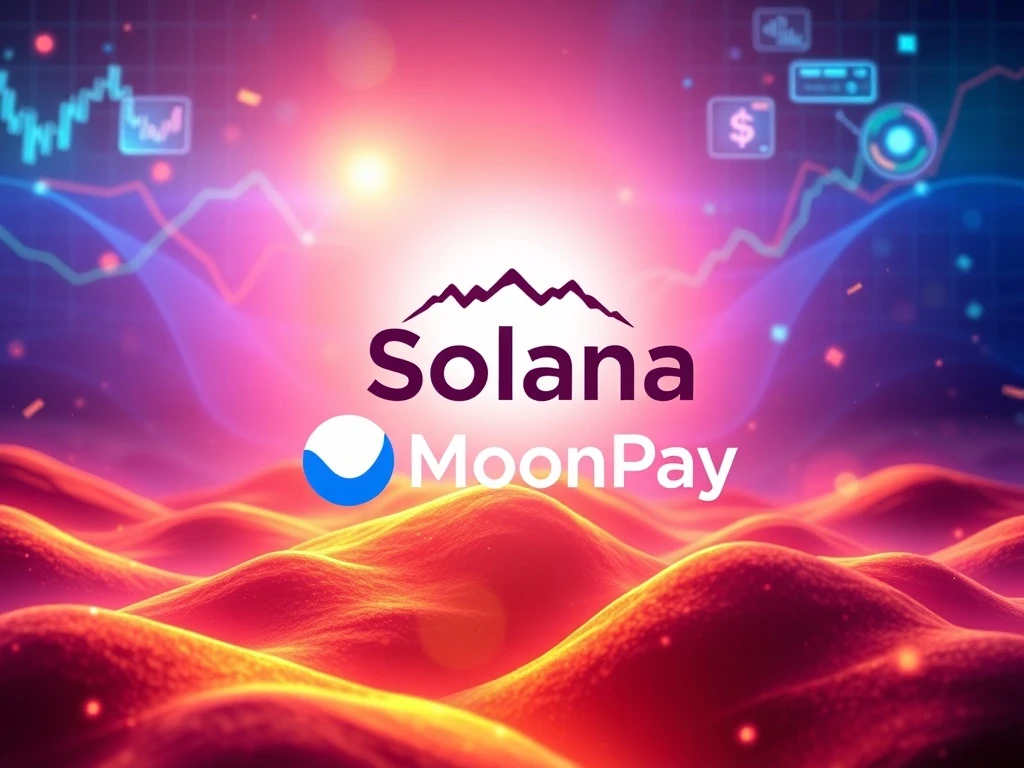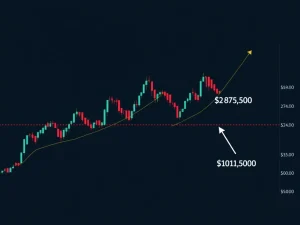Solana Staking: MoonPay Unlocking Impressive 8.49% Crypto Yields

Are you a Solana (SOL) holder looking to maximize your crypto assets? The world of decentralized finance (DeFi) is constantly evolving, and a major player just made a significant move that could redefine how you earn passive income. MoonPay, a fintech firm renowned for its cryptocurrency payment and Web3 infrastructure, has launched a game-changing liquid staking product for Solana, offering an impressive 8.49% annual yield. This bold move is set to intensify competition within the Solana staking ecosystem, challenging established native platforms and providing investors with unprecedented opportunities.
MoonPay’s Bold Entry into Solana Staking
MoonPay’s introduction of its new liquid staking product, available from July 23 (excluding New York and the EEA), marks a pivotal moment for Solana holders. This innovative feature allows users to stake as little as $1 in SOL and receive a liquid staking token known as mpSOL. What makes this offering particularly appealing is the combination of high yield and flexibility:
- Attractive Yield: An 8.49% annual yield, which is notably higher than the 8.3% offered by many Solana-native platforms.
- Low Entry Barrier: Stake as little as $1 in SOL, making it accessible to a wide range of investors, from novices to institutions.
- Frequent Rewards: Rewards are distributed every two days, providing consistent returns.
- No Lockup Period: Users can unstake their holdings without any lockup period, ensuring liquidity – a key benefit of liquid staking.
This initiative positions MoonPay directly against established Solana staking providers like Marinade and Jito, which have long dominated the market with similar yield and liquidity features. MoonPay’s CEO, Ivan Soto-Wright, emphasized the product’s user-friendliness, comparing it to the simplicity of traditional savings accounts but with the added earning potential of blockchain technology.
Why Are Crypto Yields on Solana So Attractive?
The demand for onchain yields, especially on Solana, has been surging. This isn’t just a fleeting trend; it reflects a broader shift in investor interest towards high-performing blockchain networks. Solana’s impressive staking returns are a significant draw:
- In April 2025, Solana’s total value staked briefly surpassed Ethereum’s, reaching $53.9 billion compared to Ethereum’s $53.7 billion. This highlights the growing confidence and investment in the Solana network.
- Solana staking currently provides an annualized return of 8.3%, which is substantially higher than Ethereum’s 3.2% yield. This yield differential makes Solana a highly attractive option for those seeking to maximize their crypto holdings.
The competitive landscape for crypto yields is heating up, and MoonPay’s move is a clear indication of the market’s direction. As more institutional and retail investors seek efficient ways to generate passive income from their digital assets, platforms offering robust and accessible staking solutions will gain a significant edge.
The Rising Tide: Solana’s Market Momentum
Recent market developments further underscore Solana’s increasing appeal and robust ecosystem growth:
- ETF Success: The first Solana staking ETF, launched on July 2, rapidly surpassed $100 million in volume within just 12 trading sessions. This success was largely driven by demand from registered investment advisors, signaling growing institutional interest.
- Corporate Acquisitions: Nasdaq-listed DeFi Development Corp recently expanded its Solana holdings by purchasing 141,383 SOL, bringing its total to an impressive 999,999 tokens. Similarly, Upexi increased its Solana treasury holdings by acquiring 83,000 SOL for $16.7 million.
- Brokerage Expansion: Major brokerage platforms are also recognizing Solana’s potential. Robinhood, for instance, announced plans to offer ETH and SOL staking to its U.S. customers, further democratizing access to these earning opportunities.
These developments paint a clear picture of Solana’s burgeoning ecosystem and its increasing integration into mainstream financial services. The network’s speed, low transaction costs, and high throughput continue to attract developers, users, and investors alike.
Understanding Liquid Staking and Its Advantages
MoonPay’s expansion into onchain yield builds on its evolution from a simple fiat-to-crypto gateway to a diversified Web3 platform. The company now offers a range of services, including NFTs and stablecoins, reflecting broader industry trends toward user-friendly blockchain solutions. The core of their new offering is liquid staking, a mechanism that addresses one of the primary drawbacks of traditional staking:
Traditional Staking vs. Liquid Staking
| Feature | Traditional Staking | Liquid Staking (e.g., MoonPay’s mpSOL) |
|---|---|---|
| Liquidity | Assets are locked, illiquid during staking period. | Receive a liquid staking token (e.g., mpSOL) that can be traded or used in DeFi. |
| Flexibility | Requires unstaking, often with a cooldown period. | No lockup period for unstaking; immediate access to funds. |
| Yield | Earn staking rewards. | Earn staking rewards PLUS potential for additional DeFi yields with the liquid token. |
| Complexity | Can be complex for new users, requires choosing validators. | Simplified process, often managed by the platform. |
While liquid staking significantly enhances liquidity, investors should remain aware of inherent risks such as validator performance and network security. MoonPay’s emphasis on low barriers to entry and frequent reward distribution aims to mitigate these concerns by catering to both novice and institutional investors looking to optimize their Solana holdings.
The Road Ahead: Challenges and Opportunities
Despite the promising outlook, the competitive landscape remains intense. Established Solana staking platforms continue to innovate, and regulatory scrutiny in key markets presents ongoing challenges. MoonPay’s decision to launch its product outside New York and the EEA highlights the complexities of navigating diverse crypto regulations globally.
Analysts note that while liquid staking boosts liquidity, investors must still consider underlying risks associated with the blockchain network and validator performance. However, MoonPay’s approach, focusing on accessibility and frequent rewards, is designed to attract a broad user base, from individuals looking for simple ways to earn to institutions seeking efficient capital deployment.
Conclusion: A New Era for Solana Yields
MoonPay’s entry into the Solana staking arena with an impressive 8.49% yield is a significant development for the crypto community. By offering a highly accessible and liquid staking solution, MoonPay is not only competing with native platforms but also expanding the reach of onchain yields to a wider audience. As Solana continues its growth trajectory, fueled by institutional adoption and robust ecosystem development, opportunities for investors to earn passive income are becoming more diverse and attractive. This move by MoonPay underscores the dynamic nature of the DeFi space, where innovation constantly creates new avenues for maximizing digital asset returns.
Frequently Asked Questions (FAQs)
Q1: What is Solana staking and how does it work?
Solana staking involves locking up your SOL tokens to support the network’s operations and security. In return, you earn rewards. Validators process transactions and maintain the blockchain, and by delegating your SOL to them, you contribute to the network’s decentralization and earn a portion of the rewards.
Q2: What is liquid staking, and how is MoonPay’s mpSOL different?
Liquid staking allows you to stake your crypto assets while still retaining liquidity. Instead of locking up your tokens, you receive a derivative token (like MoonPay’s mpSOL) that represents your staked assets. This derivative token can then be traded, used in other DeFi protocols, or unstaked without a lockup period, offering greater flexibility compared to traditional staking.
Q3: How does MoonPay’s 8.49% yield compare to other platforms?
MoonPay’s 8.49% annual yield for Solana staking is highly competitive, surpassing the 8.3% typically offered by many Solana-native liquid staking platforms like Marinade and Jito. It also significantly outperforms Ethereum’s current staking yield of around 3.2%.
Q4: Are there any risks associated with liquid staking on MoonPay?
While liquid staking offers benefits like liquidity, risks remain. These include potential smart contract vulnerabilities, validator performance issues (slashing risks if a validator misbehaves), and overall network security risks. It’s crucial to understand these factors and conduct your own research before participating.
Q5: Is MoonPay’s Solana staking available globally?
No, MoonPay’s Solana staking product is available from July 23 but excludes certain regions, specifically New York and the European Economic Area (EEA), due to ongoing regulatory complexities in those markets.
Q6: What is the minimum amount of SOL I can stake with MoonPay?
MoonPay allows users to stake as little as $1 in SOL, making it highly accessible for both small and large investors.






